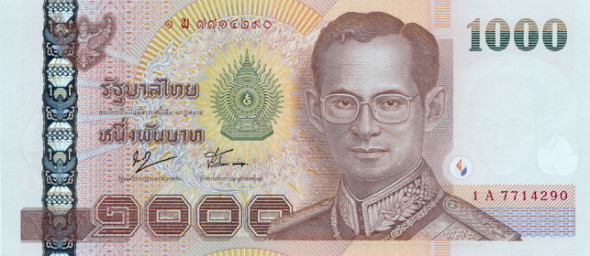Counterfeit 1,000 Baht Notes in Thailand – Don’t Get a Fake
Counterfeit 1,000 baht notes are cropping up all over Thailand
When I lived in the US, I was once chased down in a movie theatre because I had paid for my ticket with a counterfeit $20 bill.
Unbeknownst to me, I had been passed this $20 bill in my change at another shop and had innocently paid for my movie ticket with it. Fast forward five years, and the same problems are now happening in Thailand.
Thailand’s largest denomination banknote is the 1,000 baht note, which is the equivalent of around $29 at the current exchange rate.
Counterfeit 1,000 baht notes are now appearing in Thailand, and it is making some people nervous.
So much so, the news media in Thailand is warning people to make sure they check their 1,000 baht notes before they pay with them, and warning vendors to do the same before they accept them.
However, the Thai Bankers’ Association says the situation is not as bad as people are making out. Panic about counterfeit 1,000 baht notes is causing some store owners to refuse them.
There really is no need.
How to check for counterfeit 1,000 baht notes
It is quite easy to figure out if a 1,000 baht note in Thailand is counterfeit or not. The easiest way is to look at the 1,000 baht note under an ultra-violet light. It has some features that glow in the dark. The fake 1,000 baht notes do not.
If you don’t have an ultra-violet light, the words “Thai Government” are actually embossed in Thai script on the bank note.
However, I haven’t been able to find these supposedly embossed words on any of the 1,000 baht notes I have, all of which came from Bangkok Bank.
Apparently, they can be difficult to feel, so this isn’t a particularly good way of figuring out the authenticity of the note.
The best way to ascertain that the 1,000 baht note is not counterfeit is simply to hold it up to the light.
On every authentic 1,000 baht note, there is a watermark of the King of Thailand. The watermark is on the right hand side of the note if you are looking at the note from the front.
There is also a small circle to the right of the King’s neck on the front of the note (not the watermarked head of the King, the actual drawing on the front of the note).
It has an orange and a blue mark in the circle. If you hold the note up to the light, other markings will appear in that circle that will complete the orange and blue marks to make the image of a leaf-like character appear.
This, too, can only be seen on the real banknote.
As I get all my 1,000 baht notes from my bank, I don’t expect to have a problem with this. All 1,000 baht notes are supposedly being checked at Thai banks, so Thai banks won’t be passing off counterfeit 1,000 baht notes as real ones.
I was also told by a teller at Bangkok Bank that their machines are easily able to identify a counterfeit 1,000 baht note from a real one so, as long as you get all your foreign exchange needs met at a bank, you should not have any problems with fake 1,000 baht Thai notes.

